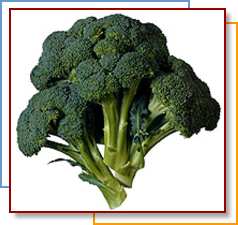Home | FOOD ARTICLES | Food Trivia | Today_in_Food_History | Food_History_Timeline | Recipes | Cooking_Tips | Food_Videos | Food_Quotes | Who’s_Who | Culinary_Schools_&_Tours | Food_Trivia_Quizzes | Food_Poems | Free_Magazines | Food_Festivals_and_Events
Food Articles, News & Features Section
FREE Magazines
and other Publications
Free Professional and Technical Research, White Papers, Case Studies, Magazines, and eBooks
BROCCOLI
See also: Broccoli Trivia; Broccoli Rabe; Broccoli Quotes
Broccoli has been around for more than 2000 years, The name "broccoli" comes for the Latin word brachium, which means "branch," or "arm." Americans have grown it in their gardens for only about 200 years! The first commercially grown broccoli was grown and harvested in New York, then planted in the 1920's in California. A few crates were sent back East and by 1925 the broccoli market was off the ground. This vegetable is highly recognized for its anti-cancer nutrients. It is a cruciferous vegetable and member of the cabbage family which is helpful in preventing certain types of cancer Varieties
Varieties
Broccoli was first grown in the Italian province of Calabria and was given the name Calabrese. Today there are many varieties. In the United States, the most common type of broccoli is the Italian green or sprouting variety. Its green stalks are topped with umbrella-shaped clusters of purplish green florets.
Did You Know
That broccoli consumption has increased over 940 percent over the last 25 years! It's a good source of Vitamin A, and vitamin C, potassium, folacin, iron and fiber. Broccoli has as much calcium ounce per ounce as milk and contains a few important phytochemicals: beta-carotene, indoles and isothiocyanates. Phytochemicals prevent carcinogens (cancer causing substances) from forming. They also stop carcinogens from getting to target cells and help boost enzymes that detoxify carcinogens. So next time you sit down to eat and broccoli is on the menu. Remember it really is good for you!
How To Select Fresh Broccoli
Choose bunches that are dark green. Good color indicates high nutrient value. Florets that are dark green, purplish, or bluish green contain more beta-carotene and vitamin C than paler or yellowing ones. Choose bunches with stalks that are very firm. Stalks that bend or seem rubbery are of poor quality. Avoid broccoli with open, flowering, discolored, or water-soaked bud clusters and tough, woody stems.
Storage
Store broccoli unwashed, in an open plastic bag and place in the crisper drawer of refrigerator. It is best if used within a day or two after purchasing.
Fresh vs. Frozen
Packaged frozen broccoli differs from fresh in its nutrient content. The flower buds or florets are richer in beta-carotene than the stalks. Manufactures typically cut off most of the stalk before packaging it, so frozen broccoli may contain 35% more beta-carotene by weight than fresh broccoli. The downside is that frozen broccoli has twice as much sodium as fresh (up to 68 mg per 10 oz. package), about half the calcium, and smaller amounts of iron, thiamin, riboflavin, and vitamin C.
Preparation and Cooking
The best way to cook broccoli is to steam, cook in the microwave or stir-fry with a little broth or water. These methods are better than boiling. Some of the vitamin and mineral content are lost from the vegetable and end up in the cooking water when they are boiled. Cooked broccoli should be tender enough so that it can be pierced with a sharp knife, and still remain crisp and bright green in color
Eat florets as a nutritious snack. Try them with a low-fat dip, or include them in your favorite salad. Think about adding two vegetables to your dinner menu, and include broccoli or another cruciferous vegetables several times a week.
RELATED ARTICLES
Please feel free to link to any pages of FoodReference.com from your website.
For permission to use any of this content please E-mail: james@foodreference.com
All contents are copyright © 1990 - 2026 James T. Ehler and www.FoodReference.com unless otherwise noted. All rights reserved.
You may copy and use portions of this website for non-commercial, personal use only.
Any other use of these materials without prior written authorization is not very nice and violates the copyright.
Please take the time to request permission.

